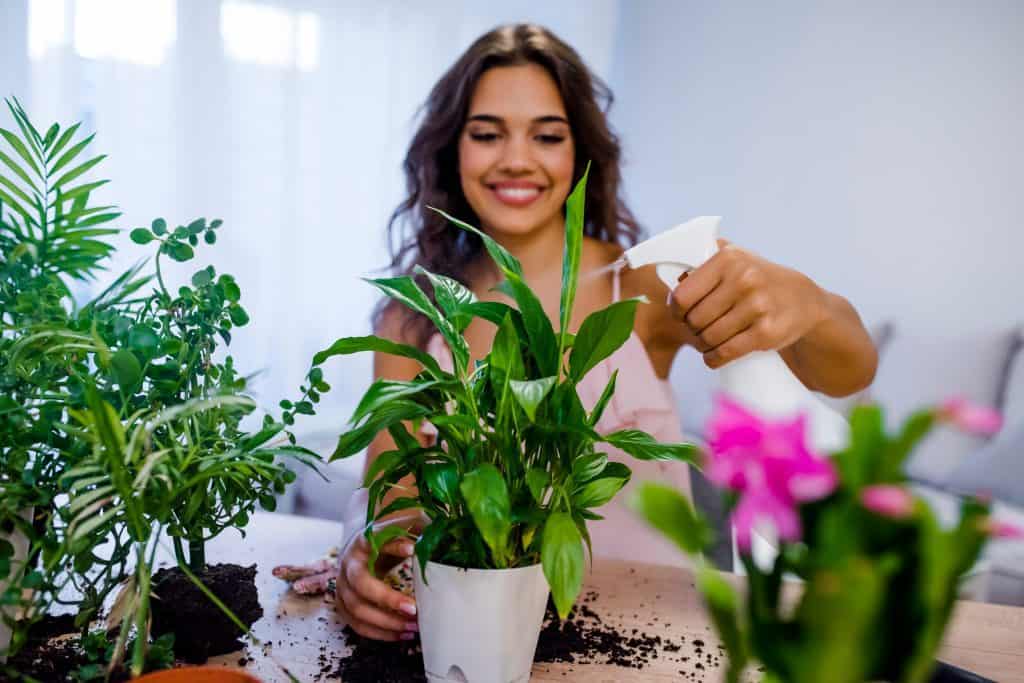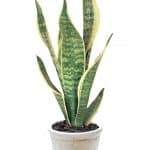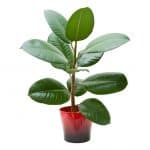Are you looking for the air purifying plants for the home? According to the Environmental Protection Agency (EPA), Americans spend about 90% of their time indoors, with a lot of that time being spent in our homes. Shockingly, indoor air is often more polluted than the air outside. When we think of air pollution, we often think of car exhaust, factories, or burning fossil fuels. However, the EPA suggests that certain harmful pollutants can be as much as 5x more concentrated inside our homes compared to outdoors.
Since we are spending so much of our time indoors, it is important to understand the health impacts of breathing in these pollutants every day. Some people will experience symptoms such as fatigue, headaches, nausea or allergies due to daily exposure. In extreme cases, serious diseases such as nervous system disorders, lung disease or cancer can develop.
However, there is a lot we can do to help remove these harmful toxins from the air. Regular cleaning, proper ventilation, and air purifiers work great. In addition, some of your favourite house plants are hard at work removing pollutants and purifying the air for you.
Dating back to the 1980s, NASA tested whether or not house plants could reduce indoor pollutants. The results proved that there are at least 50 known plants that actually purifying the air.

What Are The Most Common Pollutants In The Home?
Before we understand how to remove indoor pollutants, it’s important to understand what the pollutants are and where they come from.
Indoor air pollutants are tiny particles in the air that can have a negative impact on your health and your environment. These pollutants are found in many commercially manufactured household items, such as paint, air fresheners, particle board and upholstered furniture. Normal daily activities such as sitting by a fireplace, petting the dog, cooking and cleaning can also expose us to harmful toxins.
Here is a list of the most common indoor pollutants:
- Dust mites
- Pet dander
- Mold / mold spores
- Carbon monoxide
- Tobacco smoke
- Volatile organic compounds (VOCs)
- Pesticides
- Lead
- Asbestos
- Ozone (from some air purifiers)
- Formaldehyde
- Radon
Indoor air pollutants usually come from an indoor source, but some indoor pollutants find their way indoors from the outside. For instance, pets often track in pollution from the outside.
Here are some of the most common sources of pollution in our homes:
- Building Materials – For example, asbestos that is inside of the insulation in older buildings readily release fibers that go into the air and settle onto surfaces. New building materials present different kinds of indoor pollutants, such as the off-gassing that comes from particle board or pressed wood products.
- Combustion Sources – Combustion byproducts or carbon monoxide is released into the air whenever we heat or cook with wood or coal, warm ourselves with a fireplace, or light up a tobacco product.
- Cleaning Supplies, Insecticides, and Paints – We breathe in VOCs and other chemicals whenever we use these products to improve our homes.
- Synthetic Furnishings – These put off gas pollutants, and they also collect pet dander from pets and dust mites that love to feed on dead human skin flakes.
- Natural Sources – Mold spores and dust mites will thrive in a damp, humid environments. Further, people or pets will inadvertently bringing things in from the outside every time we enter the house.
NASA Clean Air Study
We know that many indoor pollutants are man-made, prolific, and that they can be lethal. Yet, as we spend up to 90% of our time indoors with pollutants, not much is known about indoor pollution in comparison to outdoor pollution.
It is important for people to find ways to combat these pollutants, whether or not these toxins are fully understood by researchers. Taking precautions against some of the known sources of indoor pollutions would help. For instance, air purifiers and even water purifiers would help. But we need to know and do more about the indoor pollutants we are breathing into our lungs all day long.
These issues have been around for a while, and NASA conducted a study several decades ago on the effectiveness of house plants against indoor pollutants. The original purpose was to effectively clean the air in space stations, not to help out American citizens.
NASA could have chosen to test unknown exotic plants, but they wanted to find common plants that could be easily accessed to improve indoor air quality.
Naturally, NASA knew that photosynthesis made plants absorb carbon dioxide and release oxygen. But they discovered that:
- Particular plants remove formaldehyde, trichloroethylene, benzene, and other toxins from the air.
- Plants take in toxins from the air and store them in their roots and cells. Then fungi in the soil breaks some of them down, while other toxins are stored in the plant.
- Gerbera jaimesonii (Gerbera Daisy), Sansevieria laurentii (Snake Plant), and Hedera helix (English Ivy) have the best surface area-to-chemical removal ratios.
- Larger plants and those with broad leaves generally have more capacity to remove more toxins from the air compared to smaller or thin-leaf plants have.
- One plant per 100 square feet can efficiently clean the air. However, the NASA study was conducted within a sealed space station for NASA’s own purposes, not in homes and other buildings where air is not as concentrated.
The below video does a great job of explaining the benefits of indoor houseplants:
Studies performed in homes and businesses by other organizations since then proved that micro-organisms in the soil also remove benzene from the air.
Other studies showed mixed results. Some studies suggested that plants act merely as natural humidifiers that can get rid of stale air. Plants do humidify the air, which is why they ease eyes, nose, throat, and lungs irritations. However if the air in your home is really dry, in addition to houseplants you might consider adding a cool or warm mist humidifier to certain rooms like your bedroom and living space.
And plants reduce CO2 levels in homes and offices, which gets rid of stale air.
Studies have shown that plants enhance job satisfaction, and help people maintain focus when working on projects. They reduce psychological stress and improve mood. Interacting with plants by repotting, pruning or watering them reduces stress, as does just looking at them.
However, one big disappointment was that house plants cannot significantly impact VOC levels unless one puts many plants into a small space. Perhaps millennials are really on to something with their jungalow design trend! On average, having between 15 – 20 plants in your home should do a good job of purifying the air your breathe.
Any way you look at it, the results are clear that indoor plants can improve our indoor air quality and our health.
Top 10 Air Purifying Plants For Your Home
English Ivy
 This evergreen perennial is the perfect plant for bathrooms because it effectively takes fecal particles out of the air. It grows and spreads out horizontally, serving as an eight-inch-high ground cover if planted outdoors. English Ivy also combats mold, which is great for damp spaces like a bathroom. All this plant wants in return is four hours of sunlight every day and a generous amount of water.
This evergreen perennial is the perfect plant for bathrooms because it effectively takes fecal particles out of the air. It grows and spreads out horizontally, serving as an eight-inch-high ground cover if planted outdoors. English Ivy also combats mold, which is great for damp spaces like a bathroom. All this plant wants in return is four hours of sunlight every day and a generous amount of water.
Gerbera Daisy
This delightful plant is one of the most effective ones at removing benzene, formaldehyde, trichlorethylene and carbon monoxide from the air. It can grow to be two feet tall, and people love this African plant for its bright colored flowers. It does not like to be watered from the top or to be too watered frequently. Importantly, over water of plants can actually lead to mold growth, which can be more harmful to your health. That said, if you have a serious mold problem, you may need to incorporate a dehumidifier or heavy duty air purifier.
Snake Plant / Mother-in-Law’s Tongue

Here is a great plant for your bedroom. This yellow-tipped plant releases extra oxygen during nights, which could help you to sleep better. It also removes trichloroethylene, toluene, benzene, xylene, and formaldehyde from the air. Give him love, but don’t give him an abundance of water because his roots will likely rot in moist soil. Overall, this is one of the easiest plants to care for, and on of the most effective at purifying the air.
Aloe Vera
Here is the perfect plant for a sunny windowsill. Aloe Vera is well-known for its ability to sooth burns. It also takes the formaldehyde and benzene out of the air that comes from the detergents you use and from the varnishes and floor finishes in your home. This plant mainly just wants a lot of sunlight and not too much water.
Spider Plant
This warrior against carbon monoxide and xylene can withstand some abuse from house plant newbies. Xylene is a solvent that is used in the rubber and printing industries. This plant is also super easy to propagate, creating tons of tiny new plants. This is also one of the few plants that is not toxic to animals, so great if you have pets.
Weeping Fig
 This plant has been popular in homes since Victorian times. It removes formaldehyde, xylene, and toluene from the air. This fussy plant does not like change. Keep it away from air drafts and in indirect, bright light and he’ll purify the air for you for many years.
This plant has been popular in homes since Victorian times. It removes formaldehyde, xylene, and toluene from the air. This fussy plant does not like change. Keep it away from air drafts and in indirect, bright light and he’ll purify the air for you for many years.
Peace Lily
This lovely plant with its strong dark green leaves and tall elegant white flowers boosts a room’s humidity by 5%. It also gets rid of formaldehyde, trichloroethylene, and benzene. It is easy to care for, however, it is poisonous to dogs and cats that might want to nibble on it, so do keep it out of reach of pets!
Acrea Palm
This elegant palm would make a great decorative piece for your living room or hallway. In addition to being a nice-looking larger plant, it moisturizes the air and effectively removes toxins from the air. It is easy to care for, and it even resists insect infestations.
Rubber Plant
 This larger plant was bred to be tough. It will tolerate rooms that don’t get much natural light. Designers love to use them because of their simple, large leaves. On the practical side, the Rubber Plant effectively removes formaldehyde from the air, which is a common indoor toxin.
This larger plant was bred to be tough. It will tolerate rooms that don’t get much natural light. Designers love to use them because of their simple, large leaves. On the practical side, the Rubber Plant effectively removes formaldehyde from the air, which is a common indoor toxin.
Boston Fern
These plants are full of lush foliage and long, graceful fronds. This enables them to grab toxins from the air and increase the humidity levels. All it needs to be happy is regular watering and misting of the leaves.
Best Air Purifying Plants for the Home Summary
We have seen an increase in the level of toxins in our living and working spaces during an time when we are spending more and more time indoors than ever before. This is having serious impacts on our health, but there’s a lot we can do to combat the pollution. Regular cleaning, ventilation, air purifiers are great at removing toxins from the air. Indoor plants are also a natural and proven way to purify our air. When we give these special plants what they need, they will love us back, purifying the air that we breathe. Each plant requires different care. All you need to do is to learn what they need in the way of sunlight exposure and watering, and you’ll be well on your way to cleaner air in your home.
For more like this, check out our latest posts on Humidity Control (Humidifiers & Dehumidifiers) and Air Purifying.
Latest article: check out our review of the best HVAC tool bag — whether you are a pro or novice!

